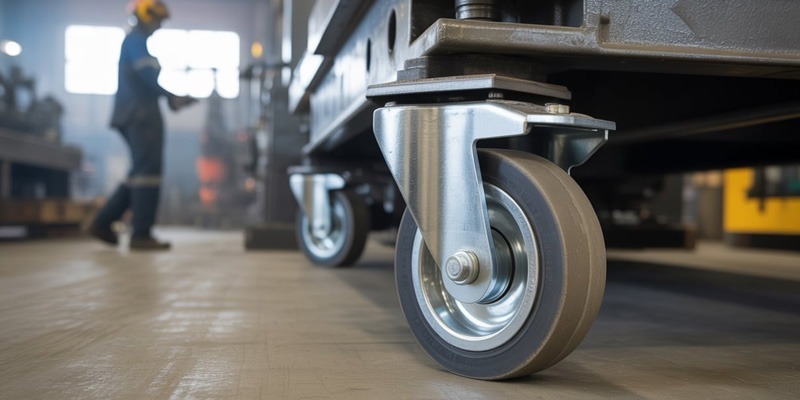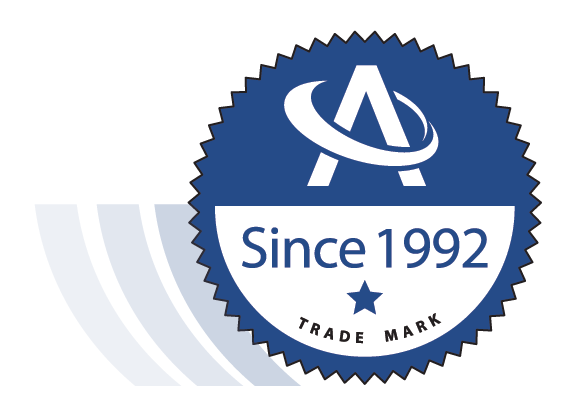How to Choose the Right Casters for Heavy Machinery
Nov 12th 2025
Casters for Heavy Machinery
In industrial environments, the performance and safety of heavy machinery depend heavily on small but essential components—casters. Whether you're moving manufacturing equipment, loading systems, or high-capacity tools, the right industrial casters play a critical role in mobility, support, and long-term operational efficiency. Without proper casters, even the most advanced equipment can face costly downtime, increased wear, or workplace safety issues.
For heavy-duty applications, standard commercial casters simply aren't built to handle the stress. Instead, heavy duty industrial casters are engineered to support substantial weight, withstand frequent movement, and endure challenging environments. One of the most important considerations when selecting the right caster is caster load capacity—the maximum weight each caster can safely support. Failing to account for load capacity often results in uneven weight distribution, mechanical damage, or even equipment failure.
In addition to load considerations, proper caster maintenance ensures durability and smooth operation, reducing long-term costs and improving workplace safety. Whether you need equipment casters for precise positioning or safety casters for stability in high-risk zones, choosing the right fit is crucial. This guide outlines everything you need to know about selecting the appropriate types of casters, managing load distribution, and extending their lifespan through regular maintenance.
What Are Casters and Their Role in Heavy Machinery?
Casters are wheel assemblies that attach to the bottom of equipment or machinery to allow movement and positioning. In heavy-duty industrial settings, they provide essential mobility while bearing significant loads. Without reliable casters, machinery becomes difficult to reposition, which affects workflow and efficiency.
There's a key distinction between industrial casters and wheels used in manufacturing and general-purpose commercial casters. Commercial-grade options often lack the durability, strength, and materials needed for high-weight operations. In contrast, heavy duty industrial casters are specifically designed to handle extreme weight and harsh conditions.
One critical element is caster load capacity. This figure represents the maximum weight a single caster can support. To prevent overload, it's vital to calculate the total load your machinery places on its casters—including both static (stationary) and dynamic (moving) loads—and distribute it evenly across all mounting points.
Different types of casters provide various functions based on mobility and application. At Atlanta Caster, we offer durable superior casters in configurations such as:
- Swivel casters for multidirectional movement
- Rigid casters for stable, straight-line transport
- Locking casters for added safety when machinery must remain stationary
Selecting the right configuration ensures safe operation, easier handling, and longer equipment life.
Types of Casters and How to Choose the Right One for Your Machinery
Understanding the types of casters is critical when configuring your heavy machinery. Each type serves a specific purpose, especially in high-load or hazardous environments.
Swivel Casters
Swivel casters allow the wheel to rotate 360 degrees, making it easier to maneuver heavy equipment in tight or complex spaces. They are ideal for applications that require frequent repositioning. For instance, heavy machinery on a warehouse floor may need to change direction multiple times during daily operations. Atlanta Caster offers durable casters specifically designed to maintain stability while providing excellent maneuverability under heavy loads.
Rigid Casters
Unlike swivel casters, rigid casters only move forward and backward. They offer a stable base for machinery that doesn't need to turn often. Their simplicity allows them to support more weight per caster, making them well-suited for straight-line transportation of bulky equipment. Atlanta Caster's equipment casters include rigid options made from high-strength materials built for long-term use in industrial settings.
Locking Casters
Locking casters include a braking mechanism that holds the wheel—and sometimes the swivel head—in place. This is particularly important for equipment that needs to remain fixed for long periods. Safety casters of this type are commonly used in medical facilities, laboratories, or any high-risk zone where movement could cause accidents.
Safety Casters
In environments such as hospitals, labs, or explosive manufacturing zones, safety casters offer features like total-lock brakes, anti-static materials, and heat-resistant coatings. Atlanta Caster supplies durable superior casters built for these demanding applications, ensuring both stability and safety.
Choosing the correct caster type depends on your specific needs—mobility, weight, environmental exposure, and usage frequency. The right combination ensures operational efficiency and long-term performance.

Caster Load Capacity and Its Impact on Performance
Caster load capacity refers to the maximum weight a caster can bear without failure. It's a foundational factor in determining which casters are appropriate for your equipment. Exceeding this capacity leads to uneven load distribution, accelerated wear, and potential damage to the caster, the equipment, or the floor itself.
To find the right caster load capacity:
- Calculate the total weight of your machinery, including any additional loads it may carry during operation.
- Divide this total by the number of casters supporting the load.
- Add a safety margin—usually 30%—to account for dynamic movement or uneven weight placement.
For example, if your machinery weighs 2,000 lbs and rests on four casters, each caster should support at least 650–700 lbs to ensure safe operation.
In high-load environments, heavy duty industrial casters provide higher load ratings, reinforced frames, and precision-engineered wheels that withstand pressure without deforming. These casters, available at Atlanta Caster, are built from high-grade steel or polyurethane, ensuring durability even under heavy use.
Effective load distribution also involves choosing the correct caster diameter and wheel material, which help reduce rolling resistance and improve maneuverability. Don't forget the impact of caster maintenance—worn bearings or misaligned wheels can alter how load is distributed, leading to mechanical issues and safety risks.
Factors to Consider When Choosing Casters for Heavy Machinery
Selecting the right caster requires more than just checking weight limits. Consider these key factors to ensure long-term reliability and safety:
Flooring Type
The surface where your equipment operates will influence caster material and design. Smooth concrete floors may allow for smaller, hard-tread industrial casters, while rough or uneven surfaces require larger wheels with shock-absorbing features. Outdoor applications often call for pneumatic or rubber casters to handle debris and surface variations.
Environment
In industrial zones exposed to chemicals, high temperatures, or moisture, you need durable casters made from corrosion-resistant materials like stainless steel or thermoplastic rubber. Atlanta Caster supplies durable superior casters built to withstand extreme conditions, from freezer rooms to welding areas.
Mobility Needs
Does your equipment need to navigate tight aisles or large distances? If tight maneuvering is essential, swivel casters are the better choice. For heavier items that stay mostly stationary, rigid casters provide a stable solution.
Speed and Safety
Fast-moving equipment requires casters that can handle momentum without wobbling or locking up. In these cases, safety casters with advanced braking and wheel-lock systems reduce risk. Atlanta Caster's product line includes equipment casters designed for high-speed environments without sacrificing control.
Balancing all these elements helps you avoid unnecessary wear, reduce downtime, and ensure equipment performs safely under load. Always consider both industrial casters and wheels designed for specific environments and tasks.
How to Maintain Your Casters for Long-Term Durability
Routine caster maintenance is essential for keeping your machinery in good working condition and extending the life of your casters.
Cleaning and Lubrication
Dirt, debris, and moisture can degrade casters over time. Regular cleaning prevents wheel obstruction, while lubrication of bearings ensures smooth rotation and reduces friction. This is especially important for heavy duty industrial casters that undergo constant use.
Inspection and Replacement
Check for cracks, flat spots, and worn bearings. Misaligned wheels or damaged frames are signs that replacements are needed. Worn equipment casters can lead to uneven movement and damage to the machinery itself.
Maintenance for Heavy-Duty Use
In industrial operations, neglecting caster maintenance can lead to downtime or safety hazards. Use maintenance intervals recommended by manufacturers, and always keep spare durable casters on hand for critical equipment. Atlanta Caster provides tips and tools to help keep your casters performing under demanding conditions.
Common Mistakes to Avoid When Choosing Casters for Heavy Machinery
Choosing the wrong caster setup can result in performance issues, equipment damage, and safety concerns. Avoid these common pitfalls:
Overlooking Load Capacity
A frequent mistake is underestimating caster load capacity. If you don't account for full load distribution, you risk overloading some casters while underutilizing others.
Ignoring Floor Surface Conditions
Hard wheels on uneven floors can wear down quickly or even damage flooring. Always match the caster material to the floor conditions for longer caster life and smoother operation.
Selecting the Wrong Material
Different environments require different materials. Using soft rubber casters in high-heat areas or hard plastic in chemical zones can lead to rapid degradation. Always match material to the environment.
Avoid these issues by working with a trusted supplier like Atlanta Caster. Our experts will help you choose the right industrial casters and wheels for your specific application.

Why Invest in High-Quality Casters for Heavy Machinery?
Choosing durable superior casters offers more than short-term benefits. High-quality casters reduce downtime, improve load handling, and ensure a safer work environment.
Performance and Safety
Reliable heavy duty industrial casters handle movement more efficiently, reduce strain on machinery, and increase operator control—especially important in high-risk environments.
Long-Term Savings
While lower-cost commercial casters may seem economical, they often wear out faster and require more frequent replacement. Investing in durable casters from Atlanta Caster helps minimize maintenance costs over time.
Ultimately, high-quality equipment casters contribute to a more efficient, safer, and cost-effective operation.
FAQs
1. What is the difference between swivel and rigid casters?
Swivel casters rotate 360 degrees, offering easy movement in any direction—ideal for maneuvering in tight spaces. Rigid casters only roll forward or backward and are best for straight-line transport under heavy loads.
2. How do I calculate the right caster load capacity for my equipment?
Use this formula:
(Total weight of equipment ÷ Number of casters) × 1.3 (safety factor) = Required load capacity per caster.
Always round up to the next available capacity rating.
3. What are the benefits of using safety casters in industrial settings?
Safety casters offer locking mechanisms, anti-static properties, and better control. They reduce the risk of unintentional movement and accidents, especially in hazardous zones.
4. How often should I perform caster maintenance?
Inspect casters monthly in heavy-use environments. Look for signs of wear, misalignment, or debris buildup. Clean and lubricate moving parts regularly to maintain performance.
Final Thoughts
Choosing the right caster for heavy machinery requires careful consideration of caster load capacity, types of casters, and the operating environment. Proper load distribution, routine caster maintenance, and selecting the correct material all contribute to reliable, long-term performance.
Investing in durable casters—especially those built for heavy-duty operations—minimizes maintenance issues, improves safety, and keeps your machinery operating efficiently.
To find the right fit for your equipment, view the full selection of industrial casters, equipment casters, and heavy duty industrial casters available through Atlanta Caster. Contact us today for expert support in choosing the right solution for your operation.




 Email US
Email US
 Hours
Hours
 Visit Our Showroom
Visit Our Showroom




